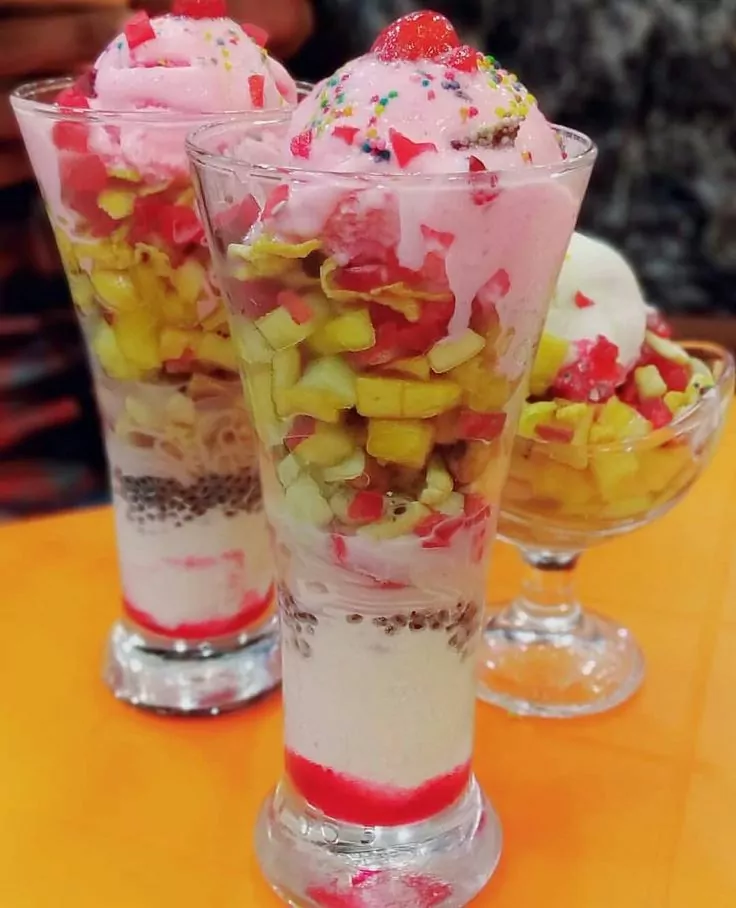The Delightful World of Falooda Flavors, Origins, Ingredients, and Recipes

Falooda is a popular and delightful dessert beverage that originated in the Indian subcontinent. This sweet treat offers a unique combination of textures and flavors, making it a favorite among dessert lovers. From its origins to the diverse range of ingredients used, let’s explore everything you need to know about falooda.
What is Falooda?

Falooda is a rich and creamy dessert beverage often served with ice cream, fruit, and sweet syrups. It consists of several layers of ingredients, including vermicelli noodles, basil seeds (sabja), rose-flavored syrup, milk, and ice cream. The result is a fusion of textures, ranging from silky smooth to chewy, along with a burst of flavors that tantalize the taste buds.
What Country is Falooda From?

Falooda finds its roots in the Indian subcontinent, where it has been enjoyed for centuries as a refreshing dessert. It is believed to have originated in Persia (modern-day Iran) and was introduced to India during the Mughal era. Over time, falooda has become an integral part of Indian, Pakistani, and Bangladeshi cuisine, with each region adding its own unique touch to the dish.
Falooda Ingredients
Vermicelli Noodles
Vermicelli noodles are one of the key components of falooda. These thin, translucent noodles are made from wheat flour or rice flour and add a delicate texture to the dessert. They are typically boiled until tender and then cooled before being incorporated into the final dish.
Basil Seeds (Sabja)
Basil seeds, also known as sabja or tukmaria seeds, are tiny black seeds derived from the sweet basil plant. When soaked in water, they develop a gelatinous outer layer. In falooda, basil seeds provide a refreshing and cooling effect, adding a unique texture to the overall experience.
Rose-Flavored Syrup
Rose-flavored syrup is another essential ingredient in falooda. It is made by infusing rose petals or rose water with sugar syrup. The resulting syrup has a fragrant floral aroma and imparts a distinct rose flavor to the dessert. The syrup is drizzled over the layers of falooda, enhancing its taste and visual appeal.
Milk
Milk forms the creamy base of falooda. It can be either regular dairy milk or variations like almond milk or soy milk for those with dietary restrictions. The milk is usually sweetened and chilled before being combined with the other ingredients to create a luscious and refreshing dessert beverage.
Ice Cream
Ice cream serves as the crowning glory of falooda. A scoop of rich and creamy ice cream, often vanilla or kulfi (a traditional Indian ice cream), is placed on top of the layered falooda. The cold ice cream melts into the dessert, adding a delightful contrast of temperature and a creamy indulgence that complements the other components perfectly.
Falooda Recipe
Here’s a simple recipe to prepare delicious falooda at home:
Ingredients:
- 1/4 cup vermicelli noodles
- 2 tablespoons basil seeds (sabja)
- 1 cup rose-flavored syrup
- 2 cups chilled milk
- 1 scoop of ice cream (vanilla or kulfi)
- Chopped nuts and fruits for garnish (optional)
Instructions:
- Cook the vermicelli noodles according to the package instructions. Once cooked, rinse them under cold water to cool them down.
- Soak the basil seeds in water for about 15 minutes until they develop a gel-like consistency. Drain any excess water.
- In serving glasses or bowls, layer the vermicelli noodles, soaked basil seeds, and rose-flavored syrup.
- Pour chilled milk over the layers, filling the glass about three-fourths of the way.
- Top the falooda with a scoop of ice cream.
- Garnish with chopped nuts and fruits if desired.
- Serve immediately and enjoy this delightful dessert!
Is it Good to Eat Falooda?
Falooda is a delicious dessert that can be enjoyed on various occasions. However, like any sweet treat, moderation is key. It is important to note that falooda is a calorie-dense dessert due to its milk, sugar, and ice cream content. If you are watching your calorie intake, it’s advisable to consume falooda in moderation as part of a balanced diet.
Additionally, falooda may contain allergens such as wheat (in vermicelli noodles) or nuts (as garnish). Individuals with dietary restrictions or allergies should be mindful of the ingredients used and make suitable substitutions or avoid certain components if necessary.
Overall, falooda offers a delightful blendof flavors and textures that make it a popular choice among dessert enthusiasts. However, it’s always advisable to enjoy it in moderation and be aware of any dietary restrictions or allergies you may have.
In recent years, falooda has gained popularity globally, with variations and adaptations being created to suit different tastes. Some innovative variations include adding fresh fruits like mango or strawberry, incorporating chocolate syrups or sauces, or even experimenting with unique ice cream flavors. The versatility of falooda allows for endless creativity in its preparation, making it a dessert that can be customized according to individual preferences.
Whether enjoyed at home or in specialty dessert shops, falooda continues to captivate taste buds with its delightful combination of ingredients. Its vibrant colors, inviting presentation, and refreshing taste make it a crowd-pleaser at parties and gatherings. Additionally, the contrasting textures of silky noodles, chewy basil seeds, and creamy ice cream create a multi-sensory experience that adds to the overall enjoyment of the dessert.
In conclusion, falooda is a delightful dessert beverage that originated in the Indian subcontinent and has captured the hearts of dessert lovers worldwide. Its unique blend of flavors, diverse range of ingredients, and customizable nature make it a truly versatile and enjoyable treat. Whether you’re savoring a classic rose-flavored falooda or exploring new flavor combinations, this indulgent dessert is sure to leave you craving for more.
